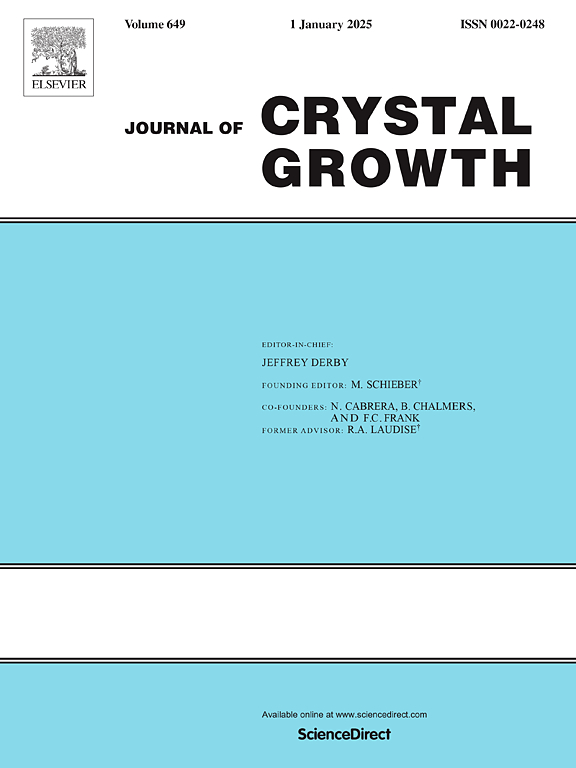Deep-ultraviolet luminescence from sp2-bonded BN films grown by metalorganic chemical vapor deposition using tris(dimethylamino)borane
IF 2
4区 材料科学
Q3 CRYSTALLOGRAPHY
引用次数: 0
Abstract
sp2-bonded BN films exhibiting deep-ultraviolet luminescence peaks were grown by metalorganic chemical vapor deposition using tris(dimethylamino)borane [TDMAB, B[N(CH3)2]3] and NH3 as B and N sources, respectively. BN films with thicknesses ranging from 0.7 to 6.1 µm were grown at temperatures () between 1200 and 1500 °C, under mass-transport-limited growth conditions. The results of x-ray diffraction, transmission electron microscopy, Fourier transform infrared spectroscopy, Raman-scattering spectroscopy, and x-ray photoelectron spectroscopy confirmed the dominance of turbostratic BN and the presence of partially ordered structures such as ABC-stacked rhombohedral phases, along with minor contributions from B-O and C-N bonds. The films exhibited broad cathodoluminescence bands centered at 5.5 eV, 4.1 eV, and 3.2 eV, which are attributable to stacking defects, most probably C impurities, and possibly O impurities, respectively. One of the samples exhibited distinct zero-phonon lines at 4.14 and 4.16 eV attributable to C dimer defects in ABC-stacked (rhombohedral) and AB-stacked (Bernal) BN phases, respectively. Compared with a reference BN epilayer grown using the BCl3-NH3-N2 gas system, B[N(CH3)2]3-grown films exhibited approximately twofold higher cathodoluminescence intensities in the 5.2–6.1 eV range at 300 K, likely due to the reduced incorporation of nonradiative recombination centers. The cathodoluminescence intensity was maximized at = 1400 °C, while both higher and lower resulted in higher concentrations of nonradiative recombination centers, likely associated with C-N bonds and divacancies comprising a B-vacancy and a N-vacancy, VBVN, respectively. These results demonstrate that B[N(CH3)2]3 is a suitable B source for the deposition of luminescent BN films, offering the potential for improved deep-ultraviolet emitter performance through reduced impurity incorporation.
三(二甲氨基)硼烷金属有机化学气相沉积法制备sp2键合BN薄膜的深紫外发光
以三(二甲氨基)硼烷[TDMAB, B[N(CH3)2]3]和NH3为B源和N源,采用金属有机化学气相沉积法制备了具有深紫外发光峰的sp2键合BN薄膜。在1200 ~ 1500℃的温度(Tg)下,在质量输运受限的生长条件下,生长出了厚度为0.7 ~ 6.1µm的BN薄膜。x射线衍射、透射电镜、傅里叶变换红外光谱、拉曼散射光谱和x射线光电子能谱的结果证实了BN以涡层BN为主,并存在部分有序结构,如abc堆叠的菱面体相,以及B-O和C-N键的少量贡献。薄膜在5.5 eV、4.1 eV和3.2 eV处显示出较宽的阴极发光带,这是由于层积缺陷造成的,最可能是C杂质,也可能是O杂质。其中一种样品在4.14和4.16 eV时表现出明显的零声子线,这是由于abc - stacking(菱形)相和ab - stacking (Bernal) BN相中存在C二聚体缺陷。与使用BCl3-NH3-N2气体体系生长的参考BN脱膜相比,B[N(CH3)2]3生长的薄膜在300 K的5.2-6.1 eV范围内表现出大约两倍的阴极发光强度,这可能是由于减少了非辐射复合中心的加入。阴极发光强度在Tg = 1400°C时达到最大,而较高和较低的Tg均导致非辐射重组中心浓度较高,可能与C- n键和由b空位和n空位组成的空位(VBVN)有关。这些结果表明,B[N(CH3)2]3是制备发光BN薄膜的合适B源,通过减少杂质掺入,有可能改善深紫外发射器的性能。
本文章由计算机程序翻译,如有差异,请以英文原文为准。
求助全文
约1分钟内获得全文
求助全文
来源期刊

Journal of Crystal Growth
化学-晶体学
CiteScore
3.60
自引率
11.10%
发文量
373
审稿时长
65 days
期刊介绍:
The journal offers a common reference and publication source for workers engaged in research on the experimental and theoretical aspects of crystal growth and its applications, e.g. in devices. Experimental and theoretical contributions are published in the following fields: theory of nucleation and growth, molecular kinetics and transport phenomena, crystallization in viscous media such as polymers and glasses; crystal growth of metals, minerals, semiconductors, superconductors, magnetics, inorganic, organic and biological substances in bulk or as thin films; molecular beam epitaxy, chemical vapor deposition, growth of III-V and II-VI and other semiconductors; characterization of single crystals by physical and chemical methods; apparatus, instrumentation and techniques for crystal growth, and purification methods; multilayer heterostructures and their characterisation with an emphasis on crystal growth and epitaxial aspects of electronic materials. A special feature of the journal is the periodic inclusion of proceedings of symposia and conferences on relevant aspects of crystal growth.
 求助内容:
求助内容: 应助结果提醒方式:
应助结果提醒方式:


